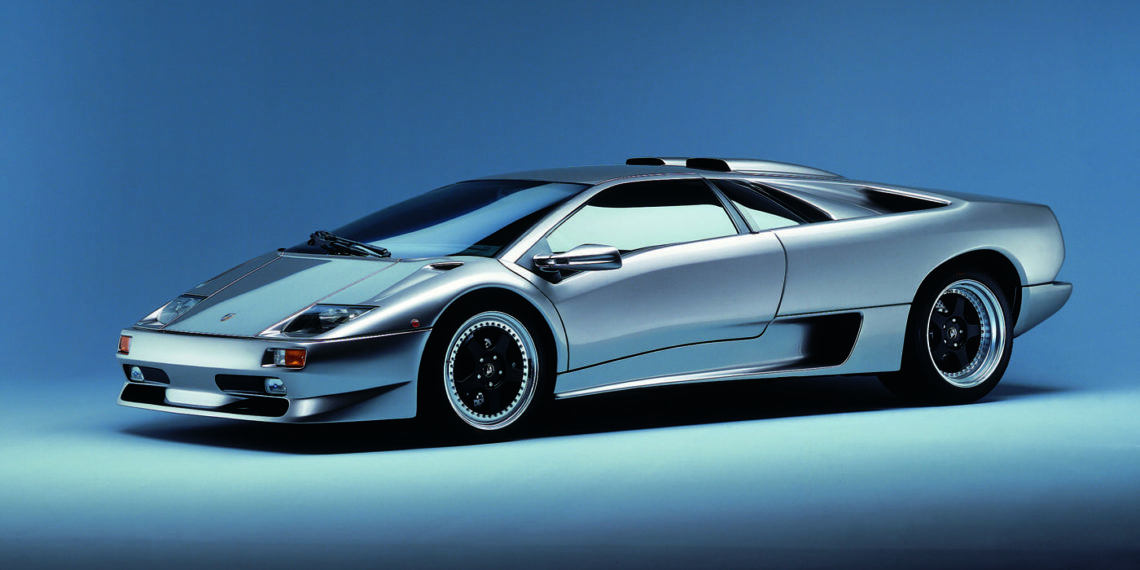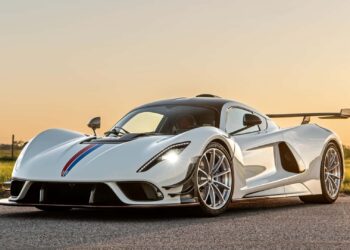Lamborghini Diablo Review
Sharp lines, vivid colors, scissor doors and a whopping 485 horsepower output were merged together to create the iconic Lamborghini Diablo specs. First placed on the market for sale to the public in 1990, it was the successor to the Lamborghini Countach. This supercar quickly proved to be just as powerful as it was breathtaking. Available as a 2-door coupe or 2-door roadster, production numbers for the Lamborghini Diablo specs come in at 2,884 throughout the span of its eleven-year run. While Lamborghini supercars were already renowned in the industry, the Diablo was the first production model released by the brand that was able to reach speeds of over 200 MPH.
Lamborghini Diablo Specs:
Horsepower: 575 hp
Torque: 457 lb-ft
0-60 mph: 3.4 seconds
1/4 Mile: 11.8 @121 mph
60-0 mph: 125 feet
Top 10 Reasons Why You Need A Lamborghini Diablo
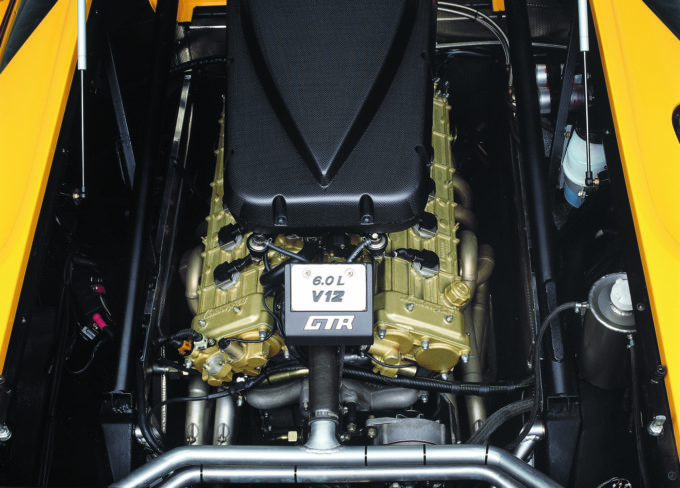
Lamborghini Diablo Engine
The original Lamborghini Diablo specs were released in 1990. They included a 5.7 liter, 48-valve rendition of the classic automaker’s Lamborghini V12 engine. This engine included a multi-point fuel injection, 485hp, and 428lb-ft of torque. As a result, the Diablo was able to boast acceleration speeds of 0 to 60 in 3.4 seconds. The top speed potential of the early Lamborghini Diablo models equipped with this particular engine is 202 MPH. By 1999, however, the V12 engine was upgraded to a 6.0-liter version which increased the maximum output to 575 hp and 457 lb-ft of torque with a maximum speed of 204 MPH.

Lamborghini Diablo Transmission
Each of the Lamborghini Diablo specs were designed around a traditional 5-speed manual transmission. Many car enthusiasts prefer the feel and control offered by 5-speed manual transmissions. The dogleg first gear makes the transmission one of the most popular components of the Lamborghini Diablo design. In today’s market, Lamborghini, along with other sports and luxury car manufacturers no longer produce models using manual transmissions. Instead, they opt to include 7-speed semi-automatic dual-clutch transmission or fully automatics. This makes the Diablo an excellent choice for those who want to reach top speeds associated with models from this time period yet prefer not to operate a vehicle with a semi-automatic or fully automatic transmission.

Lamborghini Diablo Brakes
From 1990 to 2001, all of the Lamborghini Diablo specs included Brembo servo-assisted four-wheel disc brakes. Standard Diablo models include discs with measurements of 13 inches in front and 11.2 inches in the rear. Other versions such as the VT, SE30 and VT Roadster include disc dimensions of 13 inches in front and 12.2 inches in the rear. After 1998, however, the brakes were slightly altered with Brembo servo-assisted ventilated and cross-drilled four-wheel discs. Depending on the model, the Diablo was equipped with either Kelsey-Hayes or Lucas ABS. The overall stopping distance for the later models of the Lamborghini Diablo is around 125 feet from 60 MPH to 0; making these brakes powerful enough to keep up with the top speeds of the vehicle.
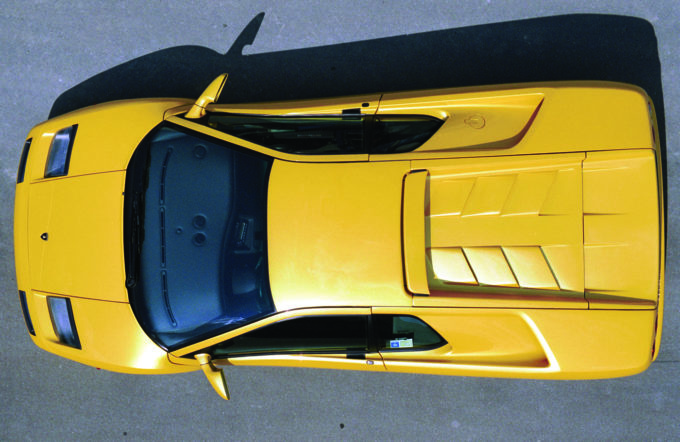
Lamborghini Diablo Design
Following the Lamborghini Countach, expectations for the Diablo were high. With the initial design constructed by Marcello Gandini and the final version perfected by Tom Gale, both designers kept speed at the forefront. Upon initial brainstorming, they determined that the Lamborghini Diablo specs would need to include speeds of at least 196 MPH to compete on the world stage. To achieve this feat, designers focused heavily on weight distribution. Another necessity was the incorporation of robust materials for the exterior of the vehicle. The final dimensions of the Diablo come in at 175.6” L x 80.3 W x 43.5” H. Fully loaded curb weights ranging between 3,053lbs (Diablo SV-R) to 3,651lbs (Diablo 6.0 VT).

Lamborghini Diablo Price
Production of the Lamborghini Diablo ceased in 2001 after the introduction of its successor, the Lamborghini Murcielago. Many of the Lamborghini Diablo models produced in the last years of production were released in limited numbers, such as the VT 6.0 with only 40 models built. Because smaller amounts of such models were manufactured, their costs are typically higher than that of ones with higher production numbers. As with all previously owned vehicles, the Lamborghini Diablo price will vary depending on the overall condition, mileage and any upgrades that have been included. Generally, you can expect to pay anywhere from $220,000 to $350,000.
Lamborghini Diablo VT 6.0 Shows Ferrari How Snow-Donuts Are Done
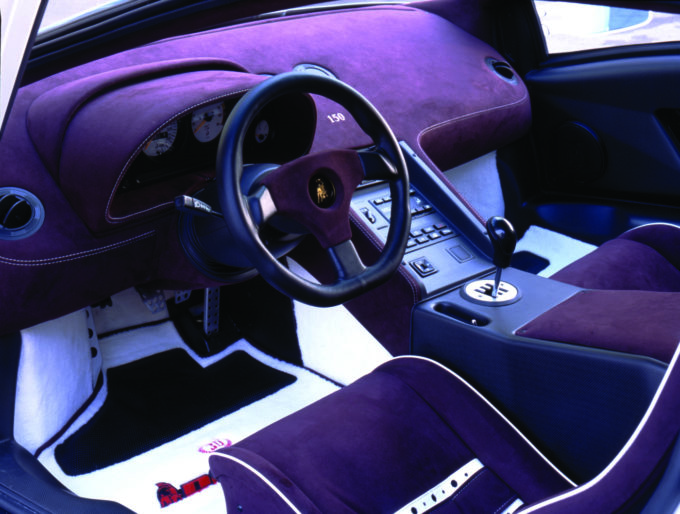
Lamborghini Diablo Interior
The interior of the Lamborghini is everything that you have come to love and expect from the luxury Italian automaker. It is filled with exquisite Italian leather and accented with bold contrasting colors. Simultaneously, the Lamborghini Diablo interior is sophisticated and functional. In the first production model, designers opted to institute a traditional flat panel dashboard. This was later abandoned in favor of a more innovative wave-shaped design. The interior also incorporates the traditional style bucket seats that Lamborghini is known for. It also featured optional upgrades like custom molded seating, 6-disc CD changer, and contrast stitching.

Lamborghini Diablo Standout Features
The Lamborghini Diablo is best known for being the first Lamborghini with the capability of reaching speeds that exceed the 200 MPH mark. Likewise, it is renowned for its signature Lamborghini scissor doors. The optional rear spoiler on the back and the anti-lock brake and power steering systems were included in the later models of. Another notable feature is the changes that were made specifically for buyers in the Mexican market. The name was changed to the Lamborghini Costanga in this region and the engine was detuned from 492 PS to 440 PS with an acceleration speed of 0 to 60 in 5.4 seconds versus the original 4.5-second speed released in other countries.
[button color=”red” text=”white” url=”https://goo.gl/xW2e3s” window=”_blank”]Browse Lamborghini Diablo For Sale[/button]
Images via Lamborghini

